Trooper Beryl McLane: End of Watch: July 30, 1954
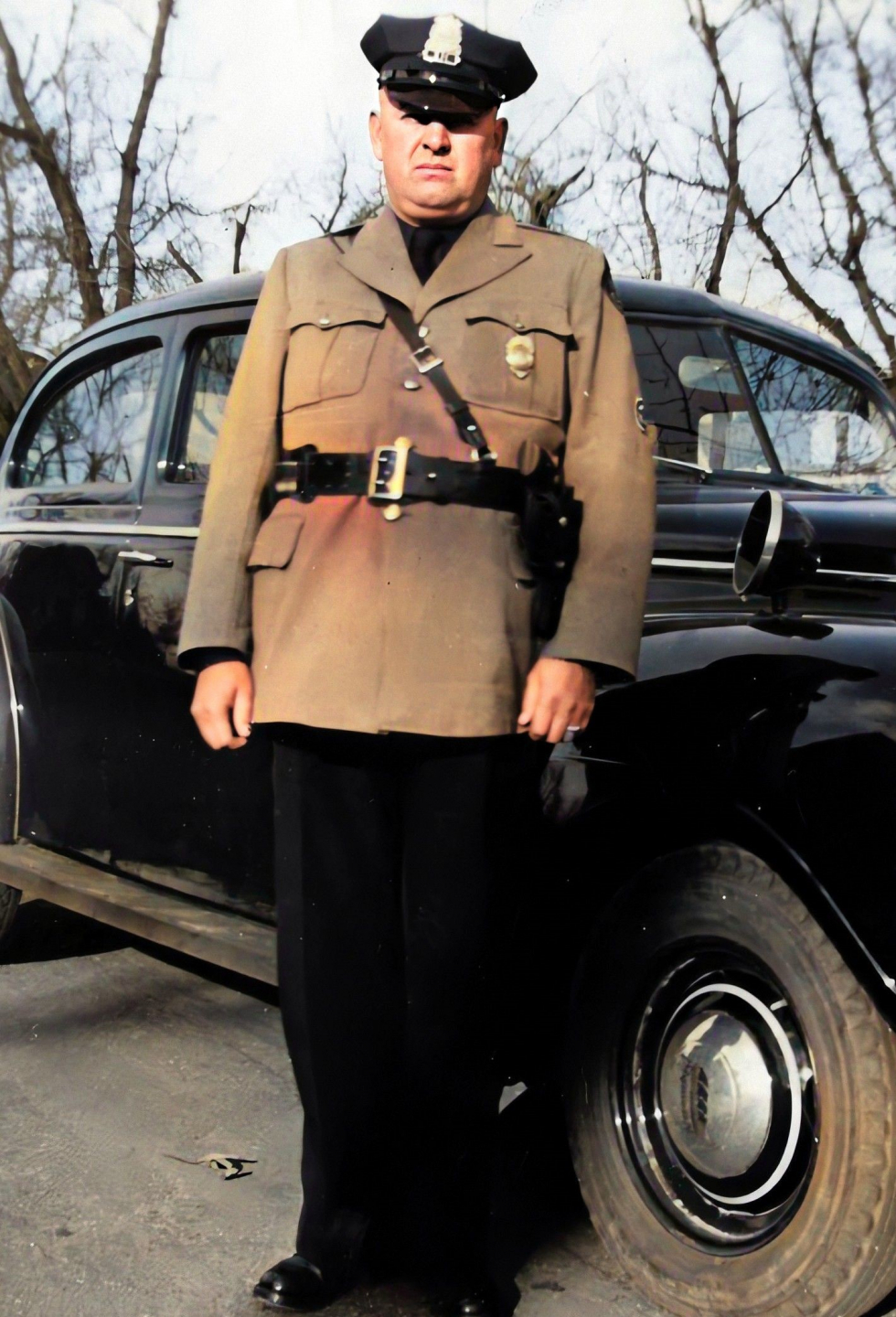
NDPOA OFFICER DOWN MEMORIAL- BERYL MCLANE
by Curt Olson, Chair—NDPOA Historical Preservation Committee, July 2024
North Dakota Highway Patrol badge number 218 was retired seventy years ago. While many badge numbers hold decades of history and the pride of those officers who wore them, badge numbers 217 and 219 have each been worn by six troopers; 218 has only been issued to one officer. All three badges were originally issued in 1941, but badge 218 has been retired since 1954.
July 30, 1954, was a typical summer day in southern North Dakota. Summer in North Dakota is often referred to as road construction season. This summer was no different. Archie Campbell and Company, a New Rockford firm, was working on a road construction project on US 281, north from Edgeley to the Stutsman County line. Precipitation was just slightly above average that year. Morning rainfall was enough to prevent the Campbell crew from working that day.
Summer, road construction, and a crew not unable to work because of rain were all seemingly normal, harmless and unremarkable circumstances for North Dakota, even today. Three construction workers, having no work for the day, added alcoholic beverages to the equation along with a drive to the James River Dam at LaMoure to do some fishing. The addition of alcoholic beverages permanently changed the trajectory for a World War I veteran, his family, the agency he worked for and the State of North Dakota.
Beryl E. McLane was born in Bradford, Illinois, on May 12, 1896. He attended school in Bradford, and at the age of 13, moved with his parents to Mitchell, South Dakota where he continued his education. He entered the United States Army during World War I, serving as a cook in the 49th Balloon Company of the Aviation Section and was honorably discharged as a private first class at Newport, Virginia.
On June 20, 1918, Beryl married Bernice Hathaway in Canton, South Dakota. The couple made their home at Mitchell until moving to Aberdeen in 1928, where Beryl began employment as a city agent for the Deep Rock Oil Company.
McLane began his law enforcement career as a patrolman with the Aberdeen Police Department, serving nine years. In 1936, he moved his family to Ellendale, ND where he served as Chief of Police.
In 1941, Governor John Moses, in his address to the legislative assembly, requested the highway patrol be expanded to accomplish a better job in traffic enforcement. The governor’s request called for a more rigid selection process to be instituted along with more stringent requirements, along with an increase of personnel. The increase was to be paid by raising driver’s license fees from twenty-five cents to one dollar.
The twenty-seventh legislative assembly reorganized the patrol to somewhat remove politics, prescribe more stringent entrance requirements, and procedures for removal that could be used only for cause. The powers and duties of the patrol were more clearly defined. The patrol’s strength was increased from 15 to 20 members.
With the Patrol’s increase in strength, Beryl E. McLane, joined the agency in 1941, being the first to wear badge number 18, his unit number was 218, He was originally stationed at Jamestown where he served seven years, prior to transferring to a post at Napoleon.
McLane by all accounts was a well-liked lawman that employed aspects of community policing in his daily duties as evidenced by community members seeing him at the post office and coffee shop in Napoleon in his normal, jovial mood on July 30, 1954.
Patrolman McLane had left the Napoleon area, driving his 1953 Ford ND Highway Patrol car number 218, working his way toward LaMoure, to assist Patrolman Robert Kyllingstad in a traffic check, or roadblock. In those days, the patrol would stop vehicles and check the operator’s license along with a safety check of the vehicle’s equipment. The checks were a routine activity conducted by the patrol to promote traffic safety.
During McLane’s trip from Napoleon to LaMoure, Patrolman Kyllingstad was at the office of the LaMoure County Sheriff. Meanwhile the three construction workers were having some drinks and fishing at the area dam on the James River. As their alcoholic beverage intake increased, so did their horseplay, annoying other people fishing nearby to the point where one of the other parties was prompted to call the Sheriff’s Office to report a disturbance.
At about 2:40 PM, Sheriff Carl Lindblom accompanied Patrolman Kyllingstad to the river in ND Highway Patrol car number 222. Upon arrival at the river, officers were told the three suspects who had created the disturbance had left and were westbound on ND Highway 13.
Patrolman Kyllingstad and Sheriff Lindblom drove westbound on ND Highway 13 in an attempt to catch up with the suspect vehicle. About six miles west of LaMoure, at approximately 2:50 pm, the patrolman and sheriff came upon the scene of a head-on collision involving Patrolman McLane’s 1953 Ford patrol car and the suspect’s Ford.
Kyllingstad testified that upon arrival on the crash scene, one car was straddling the center line in the middle of the roadway and the other car was on the south side of the roadway, facing in an easterly direction. Patrolman McLane, who was by all accounts killed instantly, was seated in his patrol vehicle, the final resting point on the south side of the roadway.
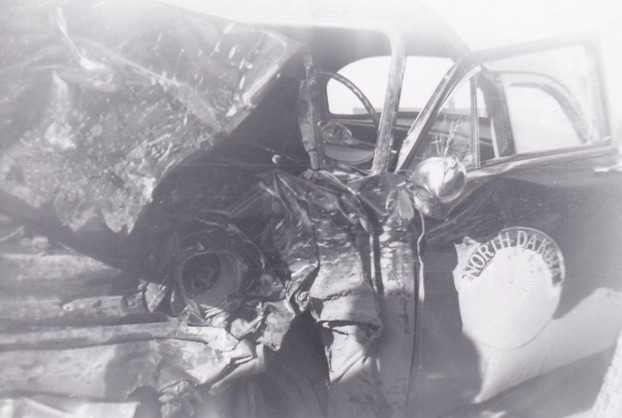
An occupant of the other car was lying on the road and another occupant was seated in the vehicle with his feet outside, touching the roadway. A third occupant, later identified as Jackson Dodd, had already left the scene, being transported to a hospital in Oakes.
Patrolman Kyllingstad identified the owner of the second vehicle, who also admitted to being the driver, as Ernest Anderson, age 26, of New Rockford. The patrolman said that Anderson was cooperative at the scene.
The other occupant, Darrell Trudeau, of New Rockford, was less than cooperative and forthcoming with information. Subsequently at sentencing, Anderson accused Trudeau of arguing with him during the drive and kicking at the steering wheel or hands of the driver. Between Trudeau and Anderson was Dodd. All three were in the front seat of the Anderson vehicle.
Anderson said he’d grabbed Trudeau’s foot and twisted it and he quit kicking for a while, but started kicking again about the time Anderson was passing a vehicle. At this time, Trudeau’s foot allegedly got caught in the steering wheel and as he turned the car back after the pass, it went too far, dropping off the edge of the roadway. Anderson admitted to driving sixty-five to seventy miles per hour, but a witness account estimated their speed at greater than 90 miles per hour. Anderson said he saw the oncoming vehicle and applied the brakes to stop.
Patrolman Kyllingstad, the primary investigator, checked the crash. Assisting him with scene photography was Patrolman Theodore Hedstrom #241, and Patrolman Earl Dosch #229 who assisted with taking measurements.
The weather at the time of the crash was scattered clouds and intermittent sunlight. Although it had rained earlier in the day, the roadway was dry. The asphalt roadway eastbound was level, however westbound was a slight upward grade that led to a hill.
The crash investigation revealed the point of impact was seven feet south of the center line of the roadway. This fact clearly establishes that Anderson’s westbound vehicle was entirely in the eastbound lane at the time of the crash.
Occupants of the Anderson vehicle later transported to a doctor in LaMoure and were later hospitalized in Oakes, under the guard of a deputy.
Anderson was arrested for Driving Under the Influence of Intoxicating Liquor. A specimen of the defendant’s blood revealed an alcohol content of 0.19%.
A coroner's inquest into Patrolman McLane’s death was convened. The three-person coroner’s jury placed the blame for McLane’s death upon Ernest Anderson who, in a reckless and heedless manner, caused McLane’s death while operating a motor vehicle while under the influence of intoxicating liquor, resulting in a charge of Manslaughter in the first degree. Jackson Dodd, age 19, of New Rockford was being charged with being drunk in a public place. The second passenger, Darrell Trudeau, was also charged with being drunk in a public place. Anderson and Dodd were released from the hospital the following Monday and were immediately taken into custody. Trudeau remained hospitalized but would face charges immediately upon release.
Dodd paid fines and costs totaling $27 and was given a 15-day suspended jail sentence. LaMoure County Judge J.V. Backlund arraigned Anderson who waived preliminary examination and bond was set at $5,000 which was immediately posted.
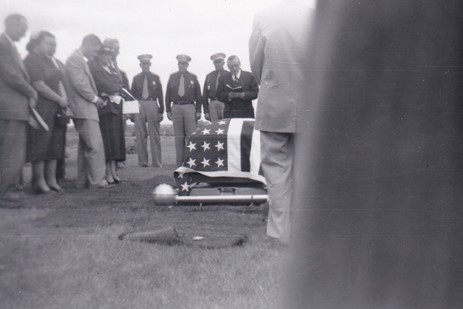
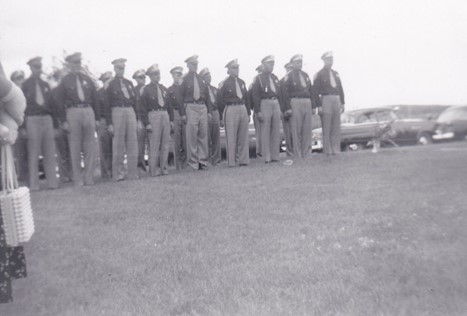
The funeral for Patrolman McLane was held at the Eddy Funeral Chapel in Jamestown on Tuesday, August 3, 1954, with Reverand N.E. McCoy and Reverand L.R. Burgum co-officiating. The funeral was attended by a majority of highway patrol members who served as an honor guard for their fallen comrade. Patrolman McLane was survived by his wife, Bernice and son, Robert, both of Napoleon; and daughter, Beverly (Olai) Attleson of Jamestown. Two brothers, Glenn of Letcher, SD, and Keith of Los Angeles, CA, and two grandsons, Jim and Ken.
McLane was laid to rest at Highland Home Cemetery in Jamestown.
One of his grandchildren who was three years old at the time, Ken Attleson, now lives in West Fargo. Ken didn’t remember the incident; however, he does remember going to Napoleon to visit his grandparents.
On Tuesday, January 11, 1955, Theodore Kessel, States Attorney for LaMoure County, filed a criminal information with Albert Porter, Judge of the District Court for the Third Judicial District, charging Ernest Anderson with Manslaughter in the first degree. The State’s Attorney listed the following as state’s witnesses: N.W. Turner, M.D., Robert S. Kyllingstad, Theodore Hedstrom, Earl Dosch, Tom Foran, Carl W. Olson, John Olson, Richard W. McGarvey, Howard Nelson, J.J. Spier, M.D., Louis Bopp, K.J. Kucera, Bernice T. Olson, Robert Muir, Homer Gibson, Darrell Trudeau, Jackson Dodds, and Sister St. Jerome.
Anderson was present in court, represented by Aberdeen, SD attorneys L.T. Van Slyck and Stanley E. Siegel. Anderson was arraigned by Judge Albert Porter and entered a plea of not guilty. Van Slyck made a motion for continuance to allow time for defense to prepare for trial.
Judge Porter set the matter of the State of North Dakota against Ernest Anderson for trial by jury on Monday, March 14, 1955, in LaMoure County District Court.
On Thursday, March 10, 1955, at 2:00 in the afternoon, a hearing was held before Judge Porter in the District Court of LaMoure County. Present at the hearing was States Attorney Thomas Kessel representing the State, and the defendant, Ernest Anderson, represented by his counsel, Stanley Siegel.
The State’s Attorney told the court the defendant had offered to withdraw his plea of not guilty, and enter a plea of guilty to the crime of Manslaughter in the second degree. The State’s Attorney said he had no objection to the reduction of the offense from first degree to second degree.
The judge told Ernest Anderson to rise and asked him if it was his intention to withdraw his guilty plea and upon acknowledgement, he allowed the same. Judge Porter asked Anderson for his plea to the charge of Manslaughter in the second degree and Anderson answered by saying, “Guilty, sir.”
The State’s Attorney called Patrolman Robert Kyllingstad to testify to establish a factual basis for the guilty plea to the charge of Manslaughter in the second degree. Kyllingstad testified that he was stationed at LaMoure and joined the patrol on April 1, 1948.
Kyllingstad testified to facts learned in the investigation of the crash. Photographs taken by Patrolman Hedstrom were admitted as evidence without objection of the defense. On cross examination, it was learned that getting information from the young men involved was somewhat initially difficult for Kyllingtstad, but he also testified that Anderson was cooperative at the scene as well as later when a statement was taken by Hedstrom and Kyllingstad.
The defense called Ernest Anderson to the stand. Anderson testified that he was twenty-seven years old and that prior to the crash he drank on occasion but didn’t describe himself as a steady drinker. He testified he hadn’t taken a drink since July 30, 1954, and further said he would never drink again. He testified that he’d only missed one church service since the crash; a Sunday when he had to go in and work.
The defense called the defendant’s wife; his employer, Archie Campbell; father; mother-in-law; and pastor.
The State read into the record a statement from Richard W. McGarvey, an eyewitness of the crash. McGarvey’s statement said he was westbound on highway 13 when a black 53 Ford came up on him fast, and passed him at a speed which he estimated to be 90 miles per hour or more, and then when it went past and cut it front of him that it careened off the pavement onto the gravel on the shoulder, then back to the pavement to the south side of the road, and back to the north side of the road, driving straight for a while before crossing back to the southside of the road where it struck an eastbound vehicle.
In his closing remarks, the State’s Attorney said he’d always somewhat felt sorry for Anderson and his circumstances of having six children, friends from New Rockford that say such nice things about him, and that it somewhat softens his heart. However he said, at the same time, there is the other side of the story where a man is minding his own business, coming over here to help with a roadblock; to do his duty as a public servant and his life is snuffed out like that (snapping his fingers) because of someone doing something the law says is not proper, and we all know is not proper, and recommended a sentence of an indeterminate time of not less than one year nor more than three years in the penitentiary.
Mr. Siegel, the defense attorney, made a long-impassioned closing statement saying a prison sentence would punish the defendant’s family, not him. He also pointed out that Trudeau and Dodds had a hand in causing the accident, and both of them walked out with suspended sentences. Siegel asked the judge to forget for the time that McLane was a highway patrolman.
Judge Porter ordered Anderson to stand and pronounced sentence of the defendant being confined to the penitentiary at Bismarck for a period not less than one year, but no more than three years and that he stands committed to the Sheriff of the county for the execution of the sentence.
LaMoure County Sheriff Fred Kupfer took custody of Anderson until he was delivered to the Warden of the North Dakota State Penitentiary.
Patrolman McLane’s wife, Bernice lived to the age of 98. She died in 1993. A footnote to this story is that Ernest Anderson died in 2008. His testimony in 1955 that he would never drink again didn’t hold true. He pled guilty to Driving Under Suspension in Mercer County in 1994 and was ordered to serve five days which would indicate the suspension came from an alcohol violation. In 2001, he was twice charged with DUI in Dunn County. He pled guilty to both charges and received a five-day jail sentence as a result of the second offense that year.
North Dakota Highway Patrol has been blessed to have only lost one member of their organization to a line of duty death in their history which now spans 89 years; a distinction not held by any other state. Two agencies, the Wyoming Highway Patrol and Hawaii Department of Public Safety/Sheriff have recorded two line of duty deaths: a sharp contrast from the California Highway Patrol’s record of 231 line of duty deaths.
In 2016, former superintendent Mike Gerhart said he was approached by Lt. Daniel Haugen with an idea to dedicate classrooms at the training academy to the memory of officers who had died in the line of duty. “I thought it was a great idea, and we moved forward with it,” said Gerhart.
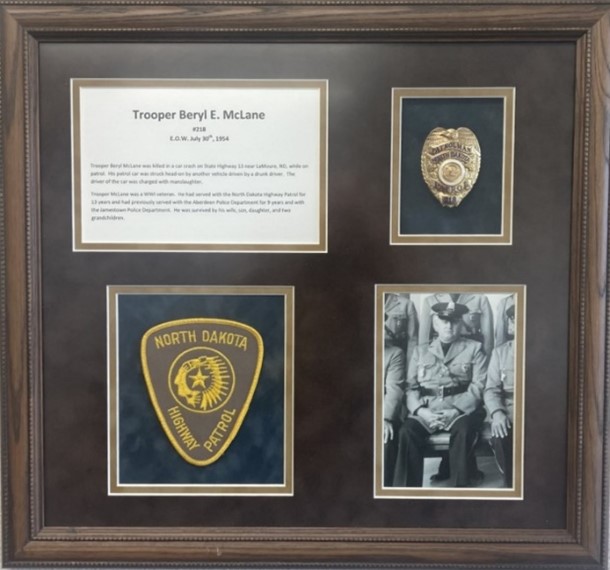
The project dedicated three classrooms and a conference room to the memory of fallen officers. Classroom number one was renamed the Deputy Bryan Sleeper (Burleigh County SO) classroom. Classroom number two was renamed the Sergeant Steven R. Kenner (Bismarck PD) classroom. Classroom number three was renamed the Officer Jason Moszer (Fargo PD) classroom. The second-floor conference room was renamed the Trooper Beryl McLane conference room. Placards with the designations were placed outside the rooms and plaques displaying a photograph of the officer, a replica of their badge, and a department patch are now displayed in each room.
In 2020, Lieutenant Daniel Haugen and Sergeant Tim Coughlin visited Highland Home Cemetery to locate McLane’s grave. Lt. Haugen said the grave was marked by a small marker and a military type headstone.
Haugen spoke to Trooper Steven Mayer, the president of the North Dakota Troopers Association and the association’s board of directors agreed to pursue the idea of replacing the grave marker which was funded by an anonymous donor.

On August 1, 2022, a new tombstone was dedicated for McLane and his wife at a ceremony at the cemetery. The new tombstone featured the North Dakota State Patrol emblem and McLane’s badge number and individual stones crafted to resemble his military footstone. Bernice McLane, the trooper’s widow, died in 1993. McLane’s grandson Ken Attleson attended the ceremony.
In 2023, as part of HB 1012, the ND Department of Transportation appropriations bill, the legislature enacted a new section to the century code designating a stretch of ND Highway 13 from Edgeley to LaMoure as the Trooper Beryl McLane Memorial Highway. Governor Doug Burgum signed the bill into law on May 18, 2023.
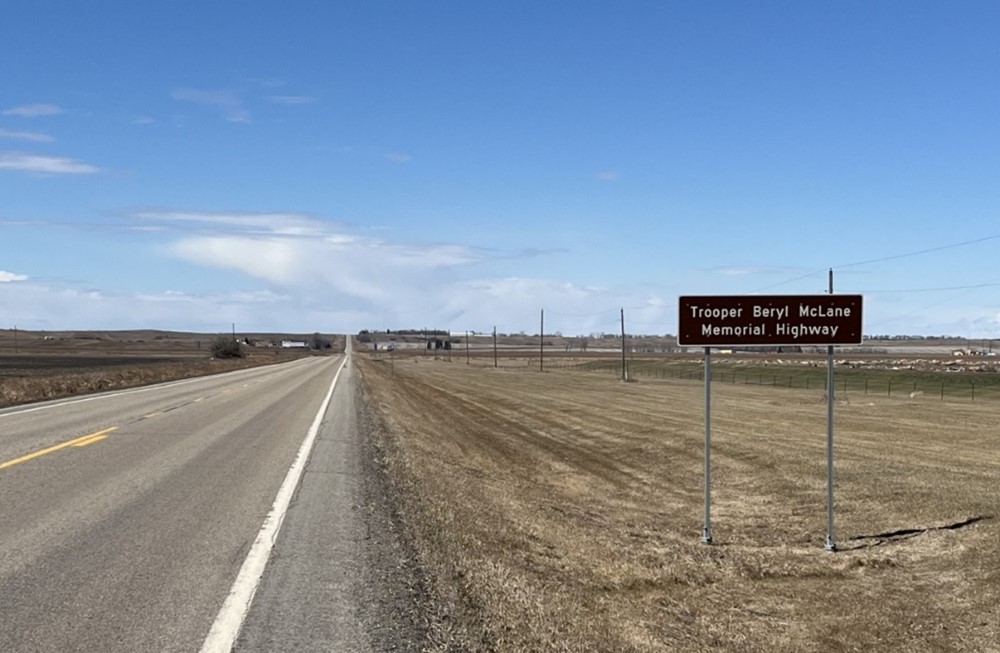
- 24-01-64. Trooper Beryl McLane memorial highway - State highway 13 - Continuing appropriation.
- The department shall designate state highway 13 from Edgeley to LaMoure as the Trooper Beryl McLane memorial highway and shall place signs along the highway designating that name. The department may accept any appropriate signs or funds donated to the department for the placement of signs. Any donated funds are appropriated to the department on a continuing basis for the purpose of providing signs designating state highway 13 as the Trooper Beryl McLane memorial highway.
- The department shall designate state highway 13 from Edgeley to LaMoure as the Trooper Beryl McLane memorial highway and shall place signs along the highway designating that name. The department may accept any appropriate signs or funds donated to the department for the placement of signs. Any donated funds are appropriated to the department on a continuing basis for the purpose of providing signs designating state highway 13 as the Trooper Beryl McLane memorial highway.
Colonel Brandon Solberg, who joined the patrol in 1999, said he became aware of McLane’s death early on in his career when learning about the agency’s history. Solberg admitted that as a new trooper he didn’t fully recognize the impact of McLane’s sacrifice, but added, “Your mindset certainly changes when you get into leadership positions and realize the devastating impact if we were to lose one of our own.”
The superintendent went on to say the responsibility of making sure all personnel get home safely weighs heavily on him as he knows it did for his predecessors.
On behalf of citizens of North Dakota, the North Dakota Highway Patrol, and North Dakota Peace Officers Association, we remember and salute Trooper Beryl McLane who made the ultimate sacrifice and laid down his life to protect the citizens of the great state of North Dakota, seventy years ago on July 30,1954. His service and sacrifice will always be remembered.
#218AlwaysRemembered
